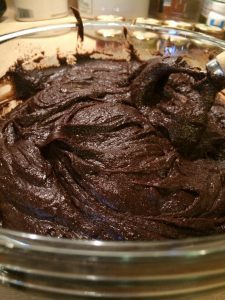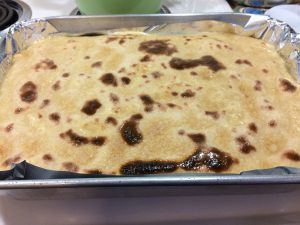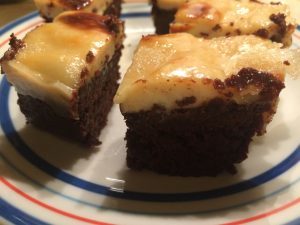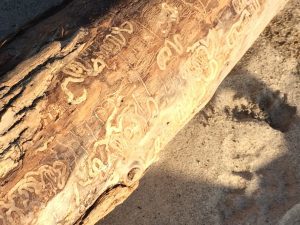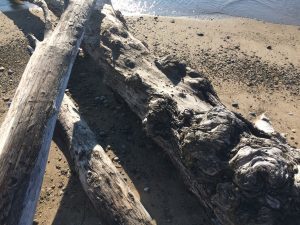Alex Gordon's Blog, page 14
November 27, 2017
Spicy Crème Brûlée Brownies
I volunteered to make one of the desserts for the Thanksgiving get-together at a friend’s house. So of course, I decided to make something I had never made before, and to make some changes to the recipe as I went along.
A few weeks before, I had stumbled into a short Twitter discussion about Mexican hot chocolate and other combinations of chocolate with spices. I am pro-spiced chocolate in bar form, and Food Network chef Aarón Sánchez has a Mexican brownie recipe containing cinnamon and cayenne pepper that’s a favorite. I hunted around some more–it didn’t take me long to find a holiday dessert that would allow me some room to experiment: Crème Brûlée Brownies. I’d never before made crème brûlée but had made other thickened sauces, and the brownie portion was similar enough in volume and ingredients to the Mexican brownies that I figured I could get away with the same amounts of spice. I didn’t want the heat to overwhelm the other flavors, but I did want it to come through.
I tweaked as I went along. I’d been replacing all-purpose flour in recipes with either white whole wheat or whole wheat pastry flour for years—they’re not as heavy or nutty-tasting as regular whole wheat flour, but they do impart some substance. They also seem to soak up more liquid than all-purpose, which means the batter was likely thicker than it would’ve been if I’d used all-purpose. I also added a little extra salt for overall flavor improvement, and a couple of teaspoons of espresso powder to boost the chocolate.
Then came the heat and spice. I started with the amounts in the Mexican brownie recipe, 1 teaspoon cinnamon and ¼ teaspoon cayenne powder. But I couldn’t detect any heat when I tasted the batter, so I doubled the amounts.
The recipe called for 20 minutes baking time. Um, no. I didn’t have a 9×13 baking pan, so I used a roasting pan with thicker sides and bottom—after 20 minutes, the center of the brownies was still liquid. So I kept them in the oven, and checked them every five minutes. It wound up taking 35 minutes for them to bake.
After the brownies were done, I moved on to the crème brûlée. I added smaller amounts of cinnamon and cayenne, then stirred stirred stirred until it thickened. It smelled so good, that rich vanilla aroma. I poured the crème over the still-warm brownies, then sprinkled sugar over the top and set them under the broiler. I had to pull them out before the sugar turned golden brown and crusty, however, as some spots turned dark brown and I didn’t want them to burn. Next time, I’ll use a kitchen torch.
Anyway, the result? Good brownies. Not as bittersweet as I prefer, but very moist and rich, with just a hint of heat from the cayenne. The crème brûlée topping was delicious; it would make a good dessert all by itself. Next time, I’ll use a different brownie recipe. I’d also like to experiment with the crème brûlée itself by adding chocolate and other flavorings.
November 13, 2017
Watching the birdies
I was never much of a bird-watcher. I liked them and enjoyed feeding them, but except for ooh-ing and ah-ing over the odd goldfinch or bluebird that dropped by for a snack, I wasn’t overly interested in the types of birds that visited my backyard.
That changed over the last few years as I visited the local state park more often and took more frequent walks along the area nature trails. The more shore birds, hawks, falcons, and songbirds I saw, the more interested I grew in learning to identify them. I downloaded Merlin Bird ID, The Cornell Lab of Ornithology bird identification app, and entered the birds I spotted. Then I started watching the birds that fed in my backyard a little more closely, the ways they interacted and the different foods they preferred, and decided I wanted to learn more.
Project Feederwatch is a joint program designed by The Cornell Lab of Ornithology and Bird Studies Canada to gather information about winter bird feeding across North America. The 2017-2018 program, which is the 31st season, began on 11 November, Veterans Day and runs until 13 April 2018. You select a portion of your yard as the count site, choose the days on which you will count, and follow the instructions about how to count and which birds to add to your tallies. Further details are available at the website.
Given that I have trouble telling some species apart, I plan on waiting to begin my observations until I work through The CLO’s online self-paced course entitled “Feeder Bird Identification and Behavior.” It begins today, 13 November. I dug out the old binoculars I inherited from my dad and set them near the south window overlooking the feeder site. I’m even considering buying a good camera with a telephoto lens so that I can take decent photographs.
I’m sure that this is all just a phase and I will be able to quit anytime I want to.
October 15, 2017
Scenes from a flight home
This past Monday, I dragged myself out of bed at oh-hell-thirty and drove to Tampa Int’l for my flight home from a writers’ conference. Even though I grumbled as I rolled my suitcase out to the rental car and headed out, I was looking forward to the trip. I’d snagged a window seat facing east, which meant I could watch the sunrise.
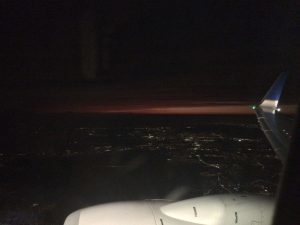
A few minutes after take-off

A few minutes later. Watch that tiny dot of light in the sky.
Planet-tracking. Venus remained in view for the dusk portion of the flight. Mars was there as well since the planets were in conjunction a few days before, but I couldn’t see it.
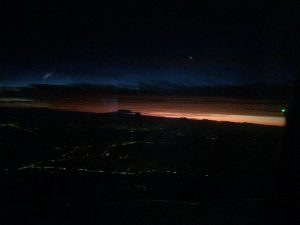
The dot’s much brighter now.

Venus faded as the sky lightened.

Layers of cloud forming a bowl
Wondering if these clouds were some portion of Hurricane Nate. The flight was bumpy at times, but nothing like I feared given that Nate had passed through there the day before.
I love spotting shapes in the clouds:

Cloudhenge

Ghostliner

Sunrise off the starboard bow
Daylight, and Lake Michigan coming into view.

The lake, complete with early morning sailor

Home, with shades of autumn amid the green
A pleasant flight. I need to nab the window seat more often.
September 29, 2017
Flowers
Autumn is here, and the recent hellish heat wave has given way to cooler weather. According to the U of I frost tracker, the first freeze of the season is only a few weeks away, which will mean bye-bye flowers. It was a good year for blooming around here, with new plants and old offering lots of color.
I took a lot of photos.
Have some hydrangea, hibiscus, roses, my favorite begonias, and a new find, Empress verbena.
And mushrooms. There’s always room for mushrooms.
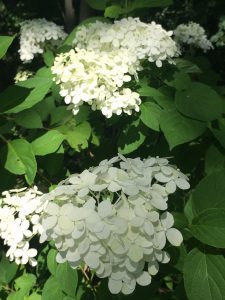
Limelight hydrangea
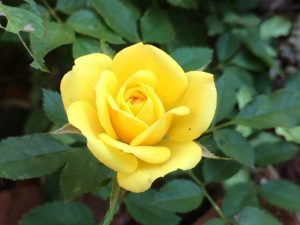
Rescue rose from a half-price table

August’s Hardy Hibiscus
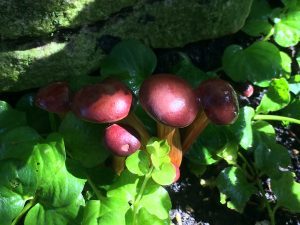
Boletus bicolor? hiding amid the greenery
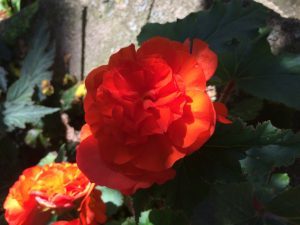
This begonia photographs bicolor, but it’s all orange
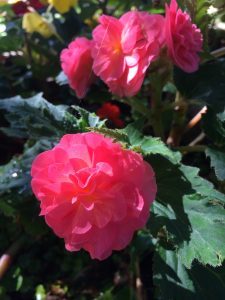
That thin line of spider silk
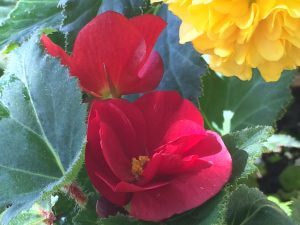
Red & yellow
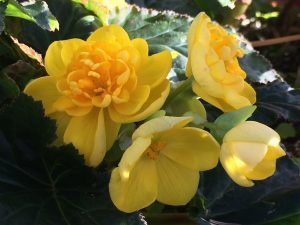
Yellow seems to photograph best

Empress verbena
September 14, 2017
Pancakes
I’m picky about pancakes. I heartily dislike most restaurant offerings, tasteless, plate-spanning platters of half-cooked batter that serve as nothing more than topping delivery devices. My Mom’s were the best, feather light with a slight crispness around the edges. She used Bisquick mix, made no additions, and didn’t do anything special that I could see other than let the batter sit for several minutes until big bubbles formed throughout. I could eat one sans topping, no syrup, powder sugar, or fruit necessary. I think that’s important. No filler foods. Everything you eat should contribute flavor to the meal.
But enough foodie blather! I wanted pancakes NOW, but 1) had no Bisquick and 2) am trying to avoid white flour anyway. Then I vaguely recalled a recipe that used banana as the base, and dug it out of the bookmark library. It’s this recipe for Three-Ingredient Pancakes for One, and it’s basically “mash a banana, add 2 tablespoons of flour and an egg, then cook.” I used Bob’s Red Mill whole wheat pastry flour, added some cinnamon and most importantly imo, a healthy pinch of salt. Poured the batter into the pan, a scant quarter-cup or so per pancake. Let them cook away while I heated up a link of tomato-basil chicken sausage. Served them with a little maple syrup, peach preserves, and blueberries because while a pancake by itself should be fine, I WANTED IT ALL.

Not bad
Final verdict–the recipe’s a keeper. Definite mild banana flavor, with the smoother consistency of an egg pancake. Next time, I would add a little vanilla, maybe some nutmeg.
Pancake appetite: Satisfied
August 21, 2017
Art in the (State) Park
Well, maybe not art in the sense of a mural, statue, or even graffiti. But there is so much stray stuff–stones, branches, bits of garbage–scattered around the trails and lakeshore, and sometimes people mess about with it, then leave it for other people to find.

“Sticks”
X marks the spot–such a simple thing. For all I know, this might’ve even been an accident. But whenever I see crossed sticks of any type, I think of the short story by Karl Edward Wagner. You know, “Sticks,” the one that brings to mind aspects of The Blair Witch Project.

“Giddy-up!”
A plastic bottle, a cap, and some weathered branches, and it’s Clint Driftwood.
(“The Ecstasy of Gold” from “The Good, the Bad, and the Ugly plays in the background)
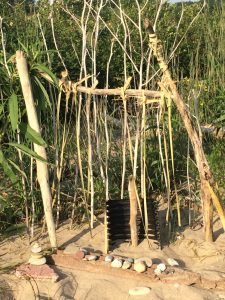
So many possible stories….
One day you have an altar…

Happy face
…and the next day, the altar is no more. Only a smiling face atop a tiny gateway.
Tiny critters that walk beneath are never seen again.
Then there are those times when Mother Nature gets into the act and puts human efforts to shame. The most striking examples are usually driftwood: sticks, branches, or occasionally large sections of trunk. I don’t know what caused the curlicue designs on this log–possibly a disease or infestation of some sort? They remind me of ancient writing or drawings.
This log’s gnarled surface reminded me of a roiling sky painted by van Gogh.
All this, in just the last few weeks.
I love my morning walks. I never know what I’ll find.
August 7, 2017
Bonsai Progress cont’d
Last month, I attended a Tropical Bonsai Workshop at Chicago Botanic Garden. A month had passed since the Beginning Fundamentals class ended, and my job since then had been to keep the ficus outdoors and make sure it was well-watered and fertilized. Over the weeks, I trimmed the larger leaves to encourage back-budding (the growth of leaves on the bare areas behind the main clusters), and fed both liquid and slow-release fertilizer. No more little fruits presented themselves, but a number of small leaves did burst forth. Theses leaves remained small, which was a good sign. That meant the tree was receiving enough sun.
The good news is that the instructor felt that given the amount of back-budding and new leaf growth, this tree had turned the corner. He had mentioned repotting towards the end of last month’s class, but felt it wasn’t necessary for now. Instead, he had me remove all the wiring–I was surprised to see that in only four weeks the branches had grown so that the wire had started to press into the wood, leaving shallow grooves behind.
After I removed the wire, the instructor trimmed back several of the branches to the point where new leaves had budded and begun to form offshoot branches. For now, the tree appears less full, but eventually the new branches will fill out and more back budding, I hope, will occur. The goal is for the interior branches to fill out, and for more branches to grow, leading to the formation of a small, “tight” tree.
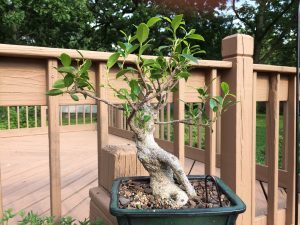
My ficus, several months on
Here’s how my tree looks now. The branches are shorter, and have been turned upward by the wiring.
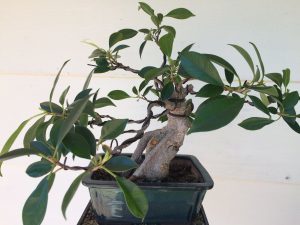
My little ficus, post-wiring.
For purposes of comparison, here’s a shot taken just after it was wired, in mid-June. The larger leaves were still in place, and the back-budding had yet to start. To be honest, I felt it looked okay. But it wasn’t considered good bonsai form as it was too “leggy” and the leaves were too big. It didn’t look like a real tree.
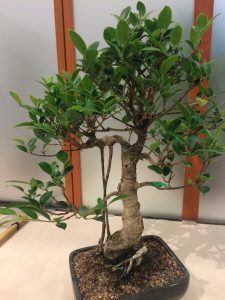
A ficus from the May show/Midwest Bonsai Society. Note the shorter branches and smaller leaves.
Here’s a ficus I saw at a recent display at the CBG. The goal is to develop a tree that looks full-size, with proportional leaves and branches. My tree still has a ways to go.
What’s next? Well, I signed up for a Fall/Winter Preparation and Storage workshop in September. When fall temperatures settle in, I will have to bring the ficus indoors because it’s a tropical tree. But I will have to provide it decent lighting so the leaves don’t grow oversized, which means acquiring a lamp of some sort. I confess that when I started all this, I didn’t expect it to be this complicated. My goal had been to learn to care for the single tree I had. But now I have three additional trees, a small spruce and two mulberry saplings, that I am considering making into bonsai, and they will need to be developed and cared for just as diligently.
What have I gotten myself into?
July 10, 2017
City Art
I visited Chicago a couple of weeks ago in order to attend the American Library Association annual conference at McCormick Place. We lucked out with the weather. Storms stayed away. Temperature and humidity moderated. Combine this with the need to hike about the South Loop to get to convention shuttle buses and enjoy the lakefront, and I had a number of opportunities to encounter city art.
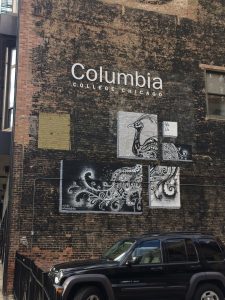
The college peacock
Columbia College occupied several buildings in the area, and I saw a number of murals that I assume were painted by students or faculty, like this lovely peacock.

Birds and Dragon?

???
I’m not really sure about the one on the left. Muppet volcano?
I think the red image in the mural on the right is a dragon.

Shadow horses
I was on a shuttle headed to McCormick Place when I spotted a lovely pair of horses.

As I draw nearer…wait for it…

…bubblemoose!
But I think my favorite was the moose.
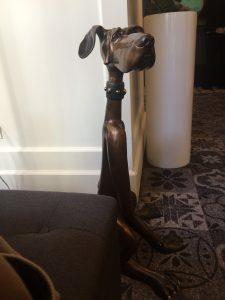
Jeeves & Bertie pup
I was also a fan of the dog figure that welcomed guests as they entered the hotel where I stayed. A “Jeeves & Bertie” pup if ever there was.
June 17, 2017
ALA and Clarion West Write-a-thon
A couple of bits of news, both of which developed like, boom:
I will be attending the American Library Association convention at McCormick Place, Chicago, on Saturday 24 June. I will be at the SFWA Table (Booth 1753) from 1-3pm as Kristine Smith. I will also be making the switch to Alex Gordon and giving away copies of GIDEON, but that time hasn’t been confirmed yet, so check back if you’re interested. In any case, stop by–I’ll be happy to sign books, programs, etc. I’ve never attended an ALA before, so I am also looking forward to visiting the other exhibits and seeing all there is to see.
I’m participating in the Clarion West Write-a-thon for the first time. I daresay most everyone who reads or writes speculative fiction knows of the Clarion Writers Workshops. I first heard of them in the 70s, when I came upon the Clarion student anthologies in the grown-up section of the library. I never attended, but so many friends have. It’s an institution, and like many such endeavors, it needs financial support. The Write-a-thon provides that via sponsorship of participating writers. The list of writers is here. Chose your writer, and you will be taken to the donation page. You don’t have to register in order to donate.
My page is here, in case you would, you know, like to sponsor me. The Write-a-thon begins tomorrow–ack!–and runs until 28 July. I will be updating the page on a regular basis with snippets of works-in-progress, along with a surprise or two.
June 15, 2017
Bonsai Progress
We’re getting a short break from a heat wave here in NE Illinois. Temps have been in the high 80s/low 90s, with gusty winds and threat of thunderstorms. Today, low 70s–at least close to the lake–and while the sun is warm, it’s cool in the shade. A good day for healing bonsai.
If you don’t know what I’m referring to, check out this post for background. Condensed version–I was given a ficus bonsai back in 2003, had so traumatized it over the years that I finally decided to learn how to take care of it, and therefore enrolled in a 6-week course at the Chicago Botanic Garden.
Right after that first post went live over at BookView Café, my tree got wired. In bonsai, that’s a good thing. My instructor did the bulk of the wiring, while I wrapped a couple of the branches under his direction. The purpose of the wiring is to support the branches as they are moved into the desired positions; as the branches grow, the wire is removed so that it doesn’t cut into the wood. The goal is to mimic the development of the tree as it interacts with its environment: the tree growing tall and straight, or crookedly through a crack in a rock or on a hillside, or in the midst of a forest.
The standard forms that bonsai can be trained to take are described here. From what I can tell, my ficus started out as a informal upright or a slanting, but that’s a guess at this point. The mess of thin branches that developed over the last few years are the result of poor care as well as simple growth after the loss of the old primary limbs. The large leaves clustered at the ends of the branches were trying to pull in as much sunlight as possible, while the lack of inner branches and leaves was due to the fact that the tree simply didn’t have the strength to develop them. The answers were: watering as needed instead of once a week, trimming larger leaves to encourage foliage growth and back-budding (growth farther down the branches), weekly feeding with a food that promotes foliage growth, and careful reintroduction to outdoor life to avoid sunburnt leaves.
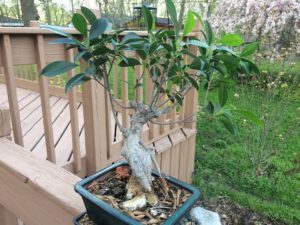
My ficus before wiring

My little ficus, post-wiring.
After I brought the tree home, I left it out on the deck, moved it from the sun to the shade as the afternoon wore on and the sunlight became too intense, and watered it daily. Trimmed a few more of the larger leaves. So far, it’s had two fertilizer feedings. The results are promising.
::jumps up and down::

Teeny tiny backbud.
We have backbuds! You can barely see the one in the photo–it’s on the right side of the left branch, in the middle/opposite the overhand curve of the wire. I’ve spotted several more on other branches, and I’m thrilled.
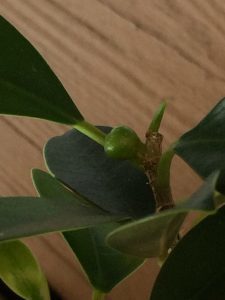
It’s a fruit! Possible this tree is a small-leaved fig.
Also, fruit! I am pretty sure that this is the first time this tree has ever fruited. It’s not a classic fig tree–there are about 90 gazillion varieties of ficus, and the classic fig is one of them–but it may be a small-leaved fig (ficus obliqua) judging from the shape of the leaves and size/location of the fruit. They’re natives of Australia and surrounding islands, and when left to their own devices tend to get whacking huge. Funny that they’re also good for development into bonsai.
Well, that’s all for now. The tree may be repotted this year, but it’s also possible that I will let it settle into the wiring and the new feeding regimen and hold off doing anything major until next year. In bonsai, you think in years. It’s definitely not a hobby for the impatient.
Alex Gordon's Blog
- Alex Gordon's profile
- 135 followers


